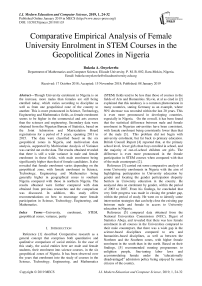Comparative empirical analysis of female university enrolment in STEM courses in the geopolitical zones in Nigeria
Автор: Bukola A. Onyekwelu
Журнал: International Journal of Modern Education and Computer Science @ijmecs
Статья в выпуске: 1 vol.11, 2019 года.
Бесплатный доступ
Though University enrolment in Nigeria is on the increase, more males than females are still being enrolled today, which varies according to discipline as well as from one geopolitical zone of the country to another. This is more pronounced in Science, Technology, Engineering and Mathematics fields, as female enrolment seems to be higher in the commercial and arts courses than the sciences and engineering. Secondary data were obtained from the Nigerian Bureau of Statistics, based on the Joint Admission and Matriculation Board registrations for a period of 5 years, spanning 2011 to 2015. The data were classified based on the six geopolitical zones in Nigeria, and multivariate data analysis, supported by Multivariate Analysis of Variance was carried out on the data. The results obtained revealed that there is still a wide variance in male and female enrolment in these fields, with male enrolment being significantly higher than that of female candidates. It also revealed that female enrolment varies depending on the geopolitical zone, with female enrolment in Science, Technology, Engineering and Mathematics being generally higher in geographical zones in southern Nigeria compared with those in northern Nigeria. The results obtained were further compared with data obtained from previous researches and the comparison was discussed. In addition, this study offers recommendations on how to encourage more female participation in Science, Technology, Engineering, and Mathematics.
University, enrolment, STEM, geopolitical zones, variance, parity
Короткий адрес: https://sciup.org/15016821
IDR: 15016821 | DOI: 10.5815/ijmecs.2019.01.03
Текст научной статьи Comparative empirical analysis of female university enrolment in STEM courses in the geopolitical zones in Nigeria
Published Online January 2019 in MECS DOI: 10.5815/ijmecs.2019.01.03
Reference [1] described Comparative research as a general concept that comprises both quantitative and qualitative comparison of social entities. In the case of this study, the social entities here are male and female students, their enrolment into science courses, in the six geopolitical zones of Nigeria. It has been observed over the years that enrolment into the study of courses in the Science, Technology, Engineering, and Mathematics
(STEM) fields tend to be less than those of courses in the fields of Arts and Humanities. Slyvie, et al as cited in [2] explained that this tendency is a common phenomenon in many countries, stating Germany as an example, where 50% decrease was recorded within the last 20 years. This is even more pronounced in developing countries, especially in Nigeria. On the overall, it has been found that the statistical difference between male and female enrolment in Nigerian universities have been consistent, with female enrolment being consistently lower than that of the male [3]. This problem did not begin with university enrolment, but far back to primary education. British Council Report [4] reported that, at the primary school level, fewer girls than boys enrolled in school, and the majority of out-of-school children are girls. The difference is even more pronounced in the female participation in STEM courses when compared with that of the male counterparts [2].
Список литературы Comparative empirical analysis of female university enrolment in STEM courses in the geopolitical zones in Nigeria
- Aderemi, H.O., Hassan, O.M., Siyanbola, W.O., Taiwo, K. (2013) Trends in enrolment, graduation and staffing of science and technology education in Nigeria tertiary institutions: A gender participation perspective. In Academic Journals, 8(21): 2011-2020, DOI:10.5897/ERR08.084, ISSN 1990-3839
- Adeyemi, K. and Akpotu, N. (2004). Gender analysis of student enrolment in Nigerian universities. Higher Education, Kluwer Academic Publishers. Printed in the Netherlands, 48: 361–378,
- Akinsowon, O. A. and Osisanwo, F. Y. (2014). Enhancing Interest in Sciences, Technology and Mathematics (STEM) for the Nigerian Female Folk. International Journal of Information Science, 4(1): 8-12 DOI: 10.5923/j.ijis.20140401.02
- Akpoyovwaire, S. M. (2014). Gender Participation in University Education in Nigeria: Closing the Gap. International Letters of Social and Humanistic Sciences Online: 2014-07-05 ISSN: 2300-2697, 34: 53-62. doi:10.18052/www.scipress.com/ILSHS.34.53
- Amelink, C. (2009). Gender Differences in Science Performance, SWE-AWE CASEE Overviews, Assessing Women in Engineering, SWE-AWE-CASEE ARP Resources, http://www.AWEonline.org. Assessed on 02/06/2018
- British Council Report (2014). Girls' Education in Nigeria: Issues, Influencers, and Actions. The British Council.
- Mills, M, van de Bunt, G. G., and de Brujin, J (2006), Comparative Research. Persistent Problems and Promising Solutions. International Sociology, 21(5): 619–631, DOI: 10.1177/0268580906067833
- National Bureau of Statistics (2016), Annual Abstract of Statistics, 1. (217)
- Sawyer, S. F. (2009), Analysis of Variance: The Fundamental Concepts, in The Journal of Manual & Manipulative Therapy n volume 17 number 2 [27-38], http://jmmtonline.com/documents/v17n2/sawyer.pdf. Assessed on 22/11/2018.
- Udeani, U. (2012), Increasing Female Participation in Science and Technology Careers: Problems and suggested Interventions from Nigeria, Developing Country Studies, ISSN 2224-607X (Paper) ISSN 2225-0565 (Online) Vol 2, No.5. http://www.cssia.org/pdf/20000193-IncreasingFemale Participationin Scienceand TechnologyCareers.pdf. Assessed on 31/7/2018
- UNESCO (2010), Gender Parity in Primary and Secondary Education, UNESCO Institute of Statistics, Fact Sheets No. 4, http://uis.unesco.org/sites/default/files/documents/fs4-gender-parity-in-primary-and-secondary-education-en.pdf. Assessed on 31/07/2018
- UNESCO (2018), Gender Parity Index, Sustainable Development Goals, UNESCO Institute of Statistics, http://uis.unesco.org/en/glossary-term/gender-parity-index-gpi. Assessed on 23/07/2018.


